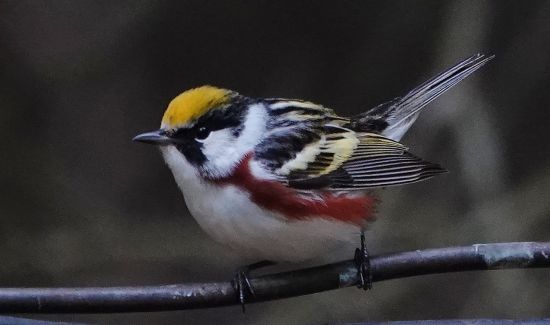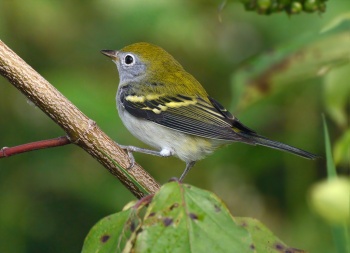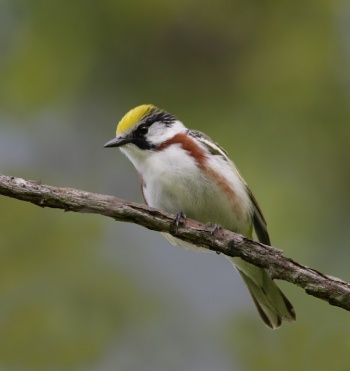- Setophaga pensylvanica
Dendroica pensylvanica
Identification
Nearly always holds tail cocked up above wingtips.
Breeding male distinct with yellow crown, black face with white cheeks, and chestnut sides.
Breeding female duller with less chestnut.
Nonbreeding male has yellow back and crown with chestnut sides.
Distribution
Eastern North America; winters Guatemala to Panama (casual northern South America)
Canada from east central Saskatchewan east to eastern Quebec, New Brunswick, and Nova Scotia south to northern half of Minnesota, Wisconsin, Michigan, northern Pennsylvania, and northern New Jersey; also along the Appalachians south to northern Georgia and eastern Tennessee and in scattered locations throughout the midwest.
In migration found throughout the east.
Rare to casual vagrant to the west.
Taxonomy
This is a monotypic species[1].
Formerly placed in genus Dendroica.
Habitat
Deciduous second growth, abandoned fields and orchards.
In migration can be found in most habitats that have at least a few trees.
Behaviour
Breeding
The clutch consists of 4 white eggs with marks of brown. Nest of bark, stems, and grass; lined with hair; usually placed low in a tree or bush. Incubated by female for 12-13 days and fledge about 10-12 days later. Cared for by both parents while in the nest.
Diet
Mostly insects including caterpillars, lice, ants, leaf-hoppers, and bark beetles. Occasional short flights while hawking flying insects. Berries and seeds when insects are scarce.
Vocalisation
Song: Please, please, please, to meet ya
References
- Clements, J. F., T. S. Schulenberg, M. J. Iliff, S. M. Billerman, T. A. Fredericks, B. L. Sullivan, and C. L. Wood. 2019. The eBird/Clements Checklist of Birds of the World: v2019. Downloaded from http://www.birds.cornell.edu/clementschecklist/download/
- Lepage D. (2021) [Avibase - https://avibase.ca/7AB1229B ]. Retrieved 1 June 2021
Recommended Citation
- BirdForum Opus contributors. (2024) Chestnut-sided Warbler. In: BirdForum, the forum for wild birds and birding. Retrieved 28 April 2024 from https://www.birdforum.net/opus/Chestnut-sided_Warbler
External Links
GSearch checked for 2020 platform.1







